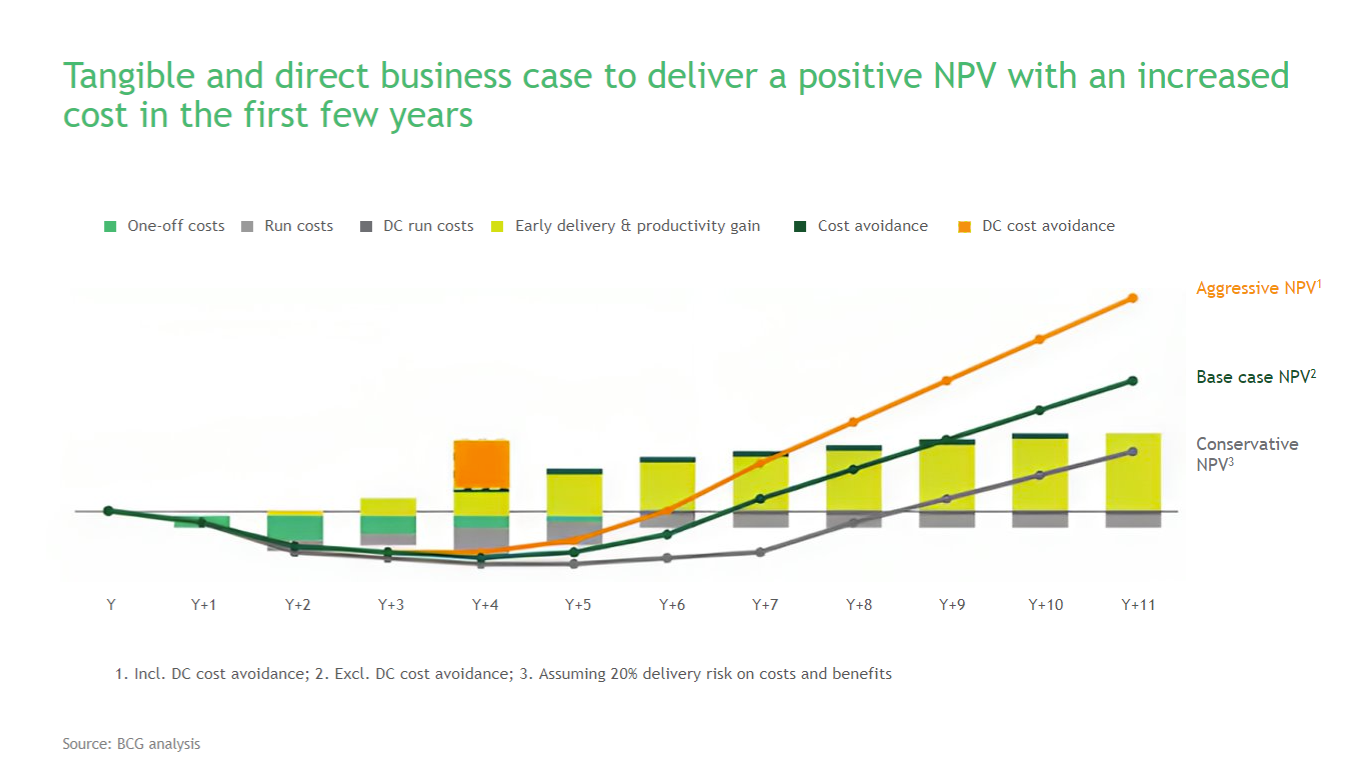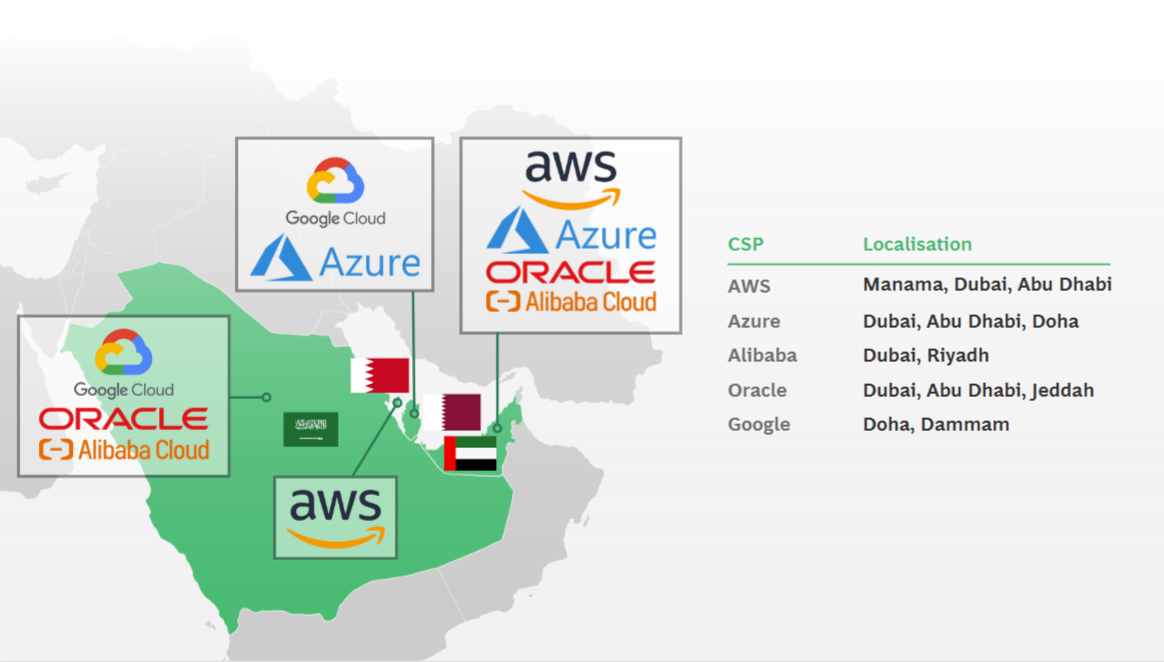As the Middle East accelerates its digital transformation journey, cloud computing is a pivotal catalyst for achieving ambitious goals in efficiency, speed, agility, performance, business model innovation, and sustainability.
The pace and depth of transformation are determined by the region’s unique characteristics, including active government involvement, country-specific regulations, evolving hyperscaler offerings, and economic polarization.
The Middle East is embracing the future of Digital & IT but is doing so on its terms and according to its timescales. In this article, BCG’s experts explore the symbiotic relationship between the Middle East’s aspirations and its distinct traits. Specifically, we examine the Middle East’s pathway toward the Cloud adoption at scale for organizations across the area.
Setting the scene
In the dynamic landscape of the Middle East, the future success of both private enterprises and government organizations is intertwined with the cloud. This strategic pivot is more than a trend; there’s a commitment to double cloud spending in the next five years to build capability and capacity while modernizing existing IT legacy infrastructure.
The region is entering a new adoption phase, with organizations harnessing the power of the cloud to achieve greater scale and maturity. Within this narrative, several key themes emerge that capture the forces driving the region’s rapid cloud adoption.
One key driver is the pursuit of cost containment and efficiency. Organizations in the Middle East are meticulously assessing their Total Cost of Ownership (TCO) and recognize that cloud technologies can deliver efficiencies through optimized resource allocation, architecture simplification/ modernization, and reduced capital expenditure. Making financial prudence a priority is explicitly linked to the region’s quest for sustainable growth.
The Middle East is using cloud technologies to accelerate the provisioning of IT services. The cloud empowers organizations to swiftly deploy resources, from computing power to storage, without the traditional bottlenecks associated with physical infrastructure. This newfound agility enables leaders to rewire traditional business processes into data-driven ones, increasing their decision making ability to respond to changing market demands and emerging opportunities.
This second cloud wave isn’t solely driven by technology—it’s about reimagining business models. By embracing cloud solutions, organizations can establish a direct connection between technology investment and business outcomes. This directly aligns IT expenditure with value creation. There’s a fundamental shift from enterprise IT provision to a strategic partnership model that drives innovation and establishes a competitive advantage.
Sustainability is a critical part of cloud technologies. It optimizes processes, harnesses cloud providers’ eco-efforts, and fosters eco-friendly digital products – aligning tech innovation with environmental responsibility.

As the Middle East seeks to harness the potential of cloud technology, organizations can benefit from the experiences and insight of businesses operating in more mature markets. A key learning point is that cloud transformation must be underpinned by a well-constructed business case and implemented with a tailored approach that considers the region’s unique characteristics.
Constructing a robust business case for cloud migration is a multifaceted challenge. When creating a business plan, organizations must consider a range of factors, including cost and investment components and direct and indirect benefits influencing the Net Present Value (NPV) of the base case.

Organizations operating in the Middle East must ensure that business strategies and cloud solutions are adapted to the region’s unique characteristics. Some of the factors to consider include:
1. The distinctive role of governments as regulators and Cloud Market Makers, selecting providers and orchestrating environment evolution. Country-specific regulations influence provider selection and establish security controls and hard requirements for data residency and access based on its classification.
2. Country-specific regulations influence provider selection and establish security controls and hard requirements for data and residency and access based on its classification.
3. An increasingly vibrant market with hyperscalers, strong local players, and high-profile joint ventures involving public and private players offering cloud services.
4. Economic polarization could accelerate the introduction of specialized players who combine cloud knowledge with vertical industry expertise.
Government as cloud market makers
Governments in the Middle East play a pivotal role in shaping the cloud landscape. Unlike their counterparts in other regions, Middle Eastern governments often act as catalysts for cloud adoption.
Governments act as cloud market makers in several ways:
1. Strategic partner appointments for cloud services
“Civilian Government entities are not allowed to buy or build new data center infrastructure. Only Government-owned Cloud Service Providers (CSPs) such as NIC can build data centers” (KSA Cloud First Policy).
"Middle Eastern governments select project partners, typically including a mixture of local and global cloud service providers. These partners are entrusted to create cloud infrastructure and deliver cloud services that cater to the unique needs and demands of the country. Governments aim to align cloud services with local requirements and regulatory frameworks by carefully selecting these partners.
2. Regulatory collaboration and shared monitoring
Operating as Cloud Market Makers, governments work closely with the appointed partners to establish and enforce regulations that govern the cloud landscape.
While regulations provide a framework for operation, governments and cloud partners share the responsibility of monitoring compliance. This collaborative approach helps balance innovation and adherence to local laws. This close collaboration ensures that cloud services are cutting-edge and compliant with the region’s legal and regulatory standards.
3. Investment and infrastructure development
Government-appointed service delivery partners are encouraged and supported to invest significantly in cloud infrastructure development. Active government involvement can include financial incentives, subsidies, or assistance in overcoming barriers to entry. This investment-driven approach is accelerating the growth of cloud services, enabling Middle Eastern nations to build a robust digital ecosystem. By fostering an environment that supports cloud infrastructure development, governments stimulate economic growth, create job opportunities, and establish a foundation for sustainable innovation.
Governments actively participate in the Middle East’s transition to the cloud. Working with a handpicked selection of partners, Government is accelerating innovation, enhancing digital capabilities, and a seamless fusion of global best practices with local requirements.
Country specific regulations
Businesses operating in the Middle East must develop a granular understanding of the country-specific regulations governing cloud operations. Unlike Western markets that benefit from homogenized regulations, there is a diverse spectrum of rules that impact cloud provider selection in the Middle East.
“A controlling entity may not transfer the personal data outside the Kingdom or disclose it to an entity outside the Kingdom, unless for the purpose of fulfilling an obligation under an agreement to which the Kingdom is a party, or of serving the Kingdom’s interests, or for other purposes as determined by the regulations […]” (KSA PDPL Article 29).
"In recent years, many Middle Eastern countries have enacted data protection laws with stringent requirements for the handling and storing of personal and sensitive data. To comply with regulations, governments enforce data residency constraints to guarantee that data is subject to local laws and protections. This is especially relevant when data is subject to strict privacy and confidentiality requirements.
Data classification is a fundamental element in the design of data policies. By categorizing data based on its sensitivity, governments can determine the appropriate level of protection and residency requirements. Critical data might require stricter residency rules, giving rise to complexities in cloud architecture and data distribution.
Hyperscaler growth

While the Middle East might not yet have the large number of hyperscale cloud providers seen in other regions, a shift is underway. As the demand for cloud services surges, local and regional hyperscalers are stepping up to meet demand.
Amazon Web Services (AWS), Microsoft Azure and Google Cloud have emerged as key players. By building data centers in Bahrain, AWS has become the first global hyperscaler to establish a tangible physical presence in the Middle East. The investment reflects the region’s demand for cloud services aligned with data residency policies.
Similarly, Microsoft Azure’s data centers in the United Arab Emirates and Qatar signify a strategic commitment to the Middle East and Google Cloud is also planning to boost the digital transformation of the region with the recent opening of the Qatar and KSA regions.
The journey towards an evolved hyperscaler landscape won’t be solely led by global giants. Alibaba Cloud, Oracle Cloud Infrastructure (OCI) have strategically invested in the Middle East. Alibaba Cloud’s approach emphasizes collaboration and partnership, aligning its offerings with the diverse needs of the region’s industries. OCI, on the other hand, focuses on industries such as finance and telecommunications, mirroring the growth areas of the Middle East.
Organizations keen on cloud services must carefully evaluate these providers based on several key factors, including service offerings, reliability, and scalability.
Economic polarization
The economic landscape of the Middle East is a mosaic of industries, each contributing to the region’s growth and evolution. Within this intricate framework, a phenomenon known as economic polarization has emerged, reflecting the varying degrees of development, modernization, and diversification among different sectors.
Three main industries play pivotal roles in the economies of Gulf Cooperation Council (GCC) countries: financial institutions, public sector & energy. Their distinct trajectories have far-reaching implications for the region’s technological evolution, including the adoption of cloud services combined with vertical industry expertise.
Concrete examples of cloud-enabled use cases across the primary Middle Eastern industries include:
Finding the way forward
The Middle East is undergoing a period of rapid transformation, with cloud technologies ushering in a new era of greater cost efficiency, speed, agility, performance, business model innovation, and sustainability. Businesses must be proactive to succeed in the challenging and rapidly changing Middle East market.

A comprehensive roadmap is critical to propelling Middle Eastern organizations toward the scale phase of cloud adoption. The plan must reflect global best practices and regional nuances. The roadmap must reflect the role of governments as cloud market makers and cover the intricate web of country-specific regulations, the dynamic landscape of hyperscaler offerings, and the challenges posed by economic polarization.
The Middle East’s technological evolution exists at the intersection of ambition and possibility. Organizations must develop unique roadmaps that translate this potential into tangible achievements and sustainable growth.
We’ve developed a 3-step process to help you develop a roadmap for cloud adoption:
Step 1 – Assess current state and landscape
- Analyze the latest Government Cloud and regulations (e.g., NDMO)
- Build or refresh use cases value map, defining the benefits and impact of cloud adoption
- Map internal relevant IT and Digital assets at a granular level, according to national guidelines on data classification and identify applicable policies (residency, privacy, sharing) and include details of all datasets
- Socialize results and constraints with business stakeholders.
Step 2 – Design the target state
- Define organization-wise cloud strategy, with a specific focus on hybrid architecture
- Prioritize data and digital platform architecture requirements, including a strong multi-cloud integration strategy
- Scout market to select best-suited vendors and technological/digital partners
- Define the target operating model and required skills and profiles
- Build a robust move-to-cloud business case and generate full buy-in from senior management.
Step 3 – Define value driven go-to-cloud roadmap
- Define a clear action plan to reach the target state, including the acquisition strategy of technological enablers
- Design roadmap to target operating model and up/re-skilling paths
- Identify the partnership and engagement model
- Secure funding and kick start the execution journey.
About the Authors
Annika Melchert is a Principal at BCG Platinion based out of Dubai. She is leading the internal initiatives “Architecture Chapter” in Middle East as well as the “FinTech & Neobanking Group”. Driven by her passion for modern banking she worked with several fintechs and incumbent banks on their technology build, integration strategies, and digital transformations. Besides, she is hosting the “Fintech Files Podcast”.





